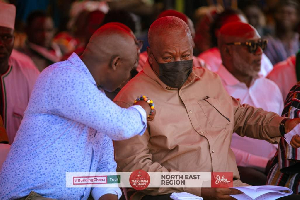Former President John Mahama (JM), the indefatigable flagbearer of the NDC stirred the hornet’s nest Sunday night during his media encounter.
He declared that he will sanitise the creation of “district assemblies” when re-elected.
JM was responding to a question posed to him by Bernard Avle of Citi FM.
Bernard Avle’s question about “261 metropolitan, municipal and district assemblies (MMDAs)” being too many and when the creation of new districts will cease was spot on.
And boy, was JM’s response insightful?
JM indicated he will seek an amendment to the constitution so the “gerrymandering” that has characterised the creation of district assemblies just to realign electoral boundaries for political gain will cease.
Under the proposed amendment, creating a district will be the same as creating a new region so that the process will lend itself to greater consensus building and prevent abuse.
JM rightly indicated that some districts are “not viable”, and unable to raise any revenues; their main source of revenue being the “District Assemblies Common Fund.”
It will be imprudent to name examples here so that we may not incur the ire of people who are sensitive to this matter.
However, the facts are out there for the objective observer who is a student of local government to verify; facts are sacred, comment is free.
JM further indicated that when he was appointed deputy minister for communications in 1997, there were less than 100 MMDAs.
Today, there are 261 and he wondered with Avle when the increase will cease.
Let’s do a back of the envelope analysis by comparing the Ablekuma West Municipal Area to the Bunkpurugu Nakpanduri District, where my mud house is located.
Both districts have a similar age profile on the population pyramid and similar birth rate.
Both the Ablekuma West Municipality and Bunkpurugu Nakpanduri District respectively have one constituency: the former is located in urban Accra, the latter, a rural area in North East Region.
The Bunkpurugu Nakpanduri District had a 27 June 2021 population of 82384 inhabiting a total surface area of 533 square kilometre, that is, 155 persons per square kilometre.
The Ablekuma West Municipal Area, on the other hand, had population of 153490 occupying a total land surface area of 15 square kilometer, that is, 10233 persons per square kilometre (!).
Thus the Ablekuma West municipality compared to my district gives us a population ratio of 2:1.
But the Ablekuma West land surface area will fit into my district 36 times (!).
Clearly, the criterion for determining district boundaries using total land surface area and population ratio as the major parameters is fraught with problems.
Even areas with higher populations or larger land size are being overlooked/have been overlooked, as JM rightly observed.
Methinks JM spoke tough political language; it may not be politically correct because many “Traditional areas” as he indicated want their exclusive districts and their Chiefs have been lobbying forever.
Given the current parochial manner of creating districts mainly for electoral gain, we risk going against the spirit of the Directive Principles of State Policy as enshrined in Chapter Six of the Constitution and the spirit of the Local Government Law (Act 462).
As the debate continues, I wish to suggest that agricultural potential is added to the criterion for creating districts.
I am creating an Agricultural Potential Index (API) which I intend to submit to the Ministries responsible for agriculture, and local government, as well as the National Development Planning Commission.
This index will include a point scoring system for districts that implement/innovate agro-engineering and genetic engineering for higher crop yield per land surface area.
After all, a significant proportion of Ghana’s population is engaged in agricultural production.
Many Ghanaians have such low skills that they can easily be trained to productive roles in the agricultural value chain/value system.
Such value chain/value system activities include manual harvesting, sorting, washing, weighing, packaging, transportation and distribution of food/food products.
All told, a 24-hour agro-based economy anchored on decentralization/devolution/local government will enhance Ghana’s comparative advantage in agriculture and needless to say, provide sustainable jobs for our teeming youth while enhancing national cohesion/integration.
Please let us bear in mind that about 23 percent of working-age Chinese are working in agriculture, cultivating nine percent of the world’s arable land and feeding 20 percent of the world’s population.
According to statista.com, in 2023, about 477 million Chinese (or 14 times Ghana’s population) lived in rural areas!
Bernard Avle and JM have opened up an important problem; let the issues-based debate begin.
Click to view details



Opinions of Friday, 12 July 2024
Columnist: Dr Abed Lamangin Bandim
Criterion For Creating District Assemblies: John Mahama and Bernard Avle have stirred the hornet's nest
Opinions


















